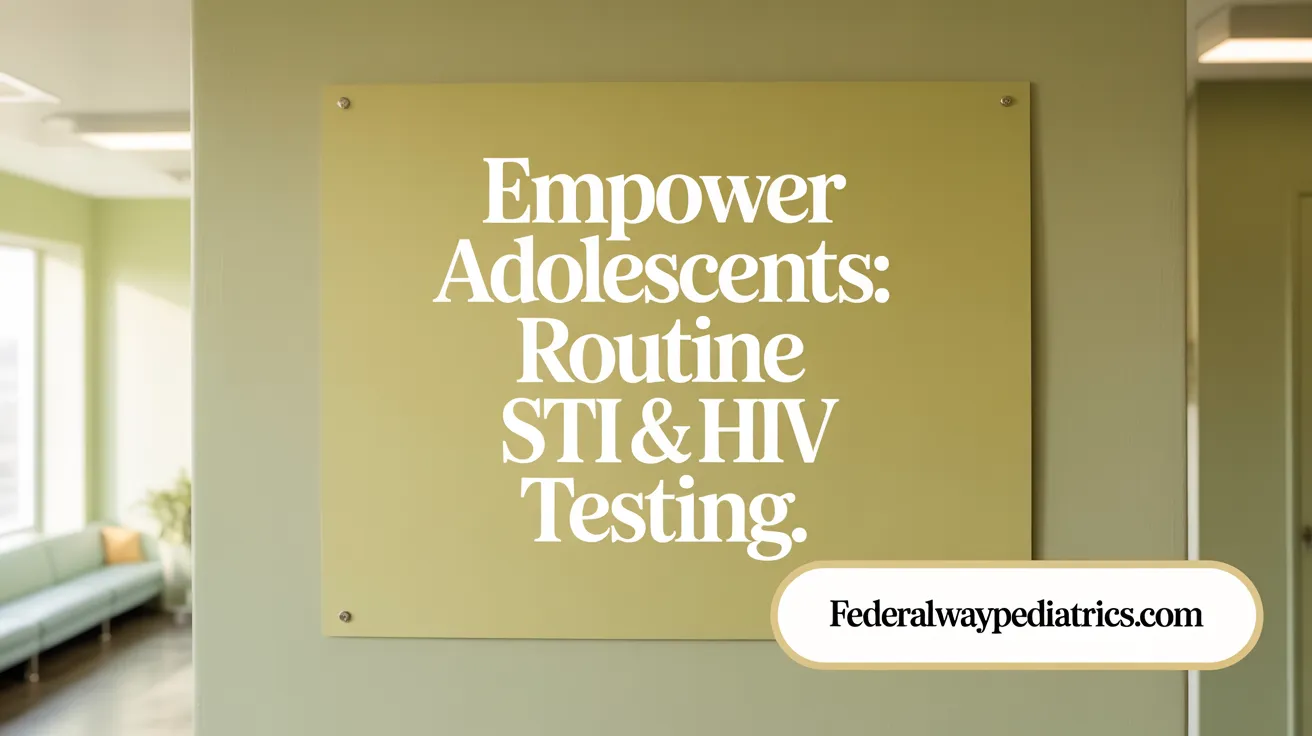Why Specialized Pediatric Tests Matter in Your Child’s Health
Importance of Early Detection in Pediatrics
Early detection through specialized pediatric tests plays a crucial role in identifying health issues before symptoms appear. This proactive approach allows for timely intervention, improving outcomes for conditions such as developmental delays, anemia, and infectious diseases.
Role of Specialized Tests in Monitoring Child Development and Health
Specialized tests, including developmental screenings, hearing and vision checks, blood tests for anemia and lead exposure, and genetic testing, are integral to monitoring a child's growth and overall health. These assessments help track milestones, detect potential health concerns, and guide individualized care plans.
Overview of Pediatric Healthcare Focus Areas
Pediatric healthcare prioritizes growth, developmental progress, immunization status, and screening for environmental and genetic risks. Regular well-child visits incorporate a range of tests tailored to various age groups, ensuring comprehensive evaluation from infancy through adolescence.
These focused approaches in pediatric testing empower caregivers and healthcare providers to support children's health and development effectively.
Key Facts on Child Health Screenings and Tests
- Hematocrit and hemoglobin tests are recommended between 9-12 months for term infants to detect iron deficiency.
- Early screening for iron deficiency preterm and exclusively breastfed infants is critical to prevent developmental delays.
- Hearing screening, including audiometry and tympanometry, should begin early to identify issues impacting language and cognitive development.
- Early detection of ear canal and middle ear issues prevents language delays and supports proper speech development.
- No blood lead level is considered safe for children, necessitating screening especially in high-risk environments.
- Blood lead testing at ages 1 and 2 years allows prompt identification and intervention to prevent cognitive damage.
- Tuberculosis screening uses TST or IGRA tests, with IGRA preferred in BCG-vaccinated children or those with follow-up challenges.
- TB screening is indicated for children with exposure risks, including recent travel or contact with active TB cases.
- Adolescents should undergo annual STI screening with NAATs and at least one HIV test between ages 15-18 for early detection.
- Routine health visits during adolescence should include comprehensive STI and HIV testing to promote sexual health and prevent transmission.
1. Iron Deficiency Screening: Hematocrit and Hemoglobin Tests

When and why are hematocrit or hemoglobin testing conducted in children?
Hematocrit testing at 9 to 12 months or hemoglobin testing for term infants is a fundamental screening test for infants recommended to detect iron deficiency detection in infants, which is a common nutritional concern that can impact a child's development.
For term infants, this blood test is typically performed between 9 and 12 months of age. Preterm infants have an earlier testing window, usually around 5 to 6 months, as they are at increased risk of iron deficiency due to less prenatal iron accumulation.
Annual screening may also be considered for menstruating adolescents who have risk factors such as heavy menstrual bleeding or poor nutrition, as iron deficiency can develop or worsen during adolescence.
Importance of testing for iron deficiency anemia
Detecting iron deficiency anemia early is critical because iron is essential for healthy brain development and overall growth. Low iron levels can lead to fatigue, impaired cognitive function, and delayed motor skills in children. Early diagnosis through hematocrit testing or hemoglobin testing allows timely intervention with dietary changes or iron supplementation.
Special considerations
Preterm infants require earlier and careful monitoring because their iron stores are lower at birth, increasing the risk of deficiency within the first six months. Exclusively breastfed infants also benefit from receiving iron supplementation starting around 6 months of age to meet developmental needs.
In summary, hematocrit and hemoglobin screenings at these targeted ages provide crucial information for preventing iron deficiency screening anemia and supporting healthy growth in infants, children, and adolescents.
2. Hearing Evaluations: Audiometry and Tympanometry for Early Detection

How are hearing issues screened in children and why early testing is important?
Early hearing screening in infants and toddlers is vital because hearing impacts speech, language, and cognitive development. Infants exhibit specific age-related responses to sound, serving as benchmarks for normal hearing. For example, a startle reaction is expected by 3 months, by 6 months babies should localize sounds, and by 18 months they typically respond to verbal commands and babble appropriately.
Formal audiometry testing usually starts at age 3, allowing detailed assessment of hearing sensitivity. Follow-up audiometry is recommended during adolescence to monitor any changes. These tests help identify hearing loss that might otherwise go unnoticed, enabling early intervention.
Tympanometry and pneumatic otoscopy are specialized examinations used to evaluate middle ear function across all pediatric ages. Tympanometry measures eardrum mobility and middle ear pressure, detecting fluid buildup or eustachian tube dysfunction, conditions that can impair hearing and speech development if untreated. Pneumatic otoscopy allows direct visualization of the eardrum with controlled air pressure to assess its movement and identify abnormalities.
Together, these methods provide comprehensive hearing evaluation. Early detection through consistent screening and testing is crucial to prevent language delays and support overall child development.
3. Lead Exposure Testing: Protecting Against Toxicity

Why is lead testing crucial and when should it be performed in children?
Lead testing is essential because no blood lead level is considered safe for children. Exposure to lead can cause serious damage to the nervous system and impair cognitive development, making early detection critical. Screening for elevated blood lead levels should be conducted based on risk assessment for lead exposure, particularly in children living in environments with older housing or other exposure risks.
How is screening conducted and who should be tested?
Testing typically involves measuring blood lead levels through blood samples. Universal screening is recommended in areas with high prevalence of lead exposure, particularly at ages 1 and 2 years. For children without identified risks, routine screening may not be necessary but should be guided by environmental risk factors or clinical suspicion. A blood lead level above 5 micrograms per deciliter signals exposure requiring intervention. Blood lead level testing in children and blood lead level risk assessment are key components of this process.
What are the benefits of early lead exposure detection?
Early identification of lead exposure can prevent long-term adverse effects on neurological and physical development. It allows for timely interventions such as removing the source of lead, nutritional support to reduce absorption, and monitoring for potential complications. Regular screening during infancy and early childhood integrates well with routine well-child visits, supporting overall child health and development.
4. Tuberculosis Screening in At-Risk Pediatric Populations

What are the protocols for tuberculosis screening in children?
Tuberculosis (TB) screening in children is crucial when there is a known or suspected risk of infection. This includes children who have had contact with anyone diagnosed with active TB, those who have recently traveled to or immigrated from countries where TB is common, or children residing in environments with increased TB exposure risk.
Screening involves either a Tuberculin Skin Test (TST) or an Interferon-Gamma Release Assay (IGRA) blood test. The traditional skin test requires injecting a small amount of purified protein derivative under the skin, with results interpreted 48 to 72 hours later. However, the TST requires a follow-up visit for reading, which may be challenging in some cases.
IGRA blood tests measure the immune response to TB proteins, offering several advantages over the skin test. IGRA testing is particularly preferred for children who have received the Bacille Calmette-Guérin (BCG) vaccine, as it is less likely to produce false-positive results due to prior vaccination. It is also the test of choice for children unlikely to return for the skin test reading or those exposed to non-tuberculous mycobacteria that can interfere with skin test accuracy.
Both testing methods require proper clinical interpretation alongside risk assessment for tuberculosis to decide on further management, including additional testing or preventive therapies.
By following these protocols, healthcare providers can effectively identify and manage TB infection in at-risk pediatric populations, ultimately helping to prevent progression to active disease.
5. Sexually Transmitted Infection (STI) and HIV Screening for Adolescents

When and how should adolescents be screened for STIs and HIV?
Routine screening tests for adolescents for sexually transmitted infections (STIs) is crucial for sexually active adolescents to detect infections early and prevent complications. Screening should be performed annually and includes testing for common STIs such as chlamydia and gonorrhea.
[Nucleic acid amplification tests (NAATs)] are the preferred method for STI screening due to their high sensitivity and accuracy, allowing for reliable detection of infections even when symptoms are absent.
HIV screening] is recommended at least once between the ages of 15 and 18 years. Early identification through screening enables timely medical intervention, counseling, and reduces further transmission risks.
Integrating STI and HIV screening into routine well-child and adolescent health visits] supports comprehensive care, promotes sexual health awareness, and empowers adolescents to manage their health responsibly.
Parents and caregivers should work with healthcare providers to ensure adolescents receive these important screenings, especially if they are sexually active or at higher risk.
Empowering Parents with Knowledge on Pediatric Specialized Tests
Importance of Regular Screening for Early Intervention
Regular pediatric screenings are crucial for identifying health issues early, from developmental delays to conditions like iron deficiency and lead exposure. Early detection through scheduled tests enables timely treatment, improving long-term outcomes and supporting your child's healthy development.
Partnering with Pediatric Healthcare Providers
Working closely with your child’s pediatrician is essential. These healthcare professionals follow recommended screening schedules and provide guidance tailored to your child’s unique needs. Open communication ensures concerns are addressed promptly and vaccinations and screenings remain up to date.
Supporting Lifelong Health Through Timely Diagnostic Testing
Specialized diagnostic tests administered at key stages—from newborn metabolic screenings to adolescent cholesterol checks—help monitor physical, cognitive, and emotional health. Timely testing supports preventive care and management of chronic conditions, empowering families to nurture health throughout childhood and beyond.
